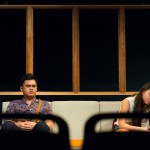“The Duchamp Syndrome”
Reviewer: Casidhe Ng
Performance: 14 January 2015
Rarely do we see a performance fixated on miniatures, toys and marionettes, but Antonio Vega’s latest brainchild/creation certainly reinvents that fixation. The Duchamp Syndrome by Por Piedad Teatro is an intriguing feat that pushes theatrical conventions at every turn, drifting between the real and surreal through a cast of colorful characters and unusual routines.
The play follows Juan (Antonio Vega), an aspiring stand-up comedian who is suffering from the eponymous “Duchamp syndrome” following an encounter with the Bicycle Wheel. His loneliness and obsession with the minute eventually results in the creation of his own friends from inanimate objects, as he struggles to find his place in the overwhelming city of New York.
Much of the play is straightforward in the way it conveys its themes. In one particular scene, the idea of growing smaller in a strange and large world is taken literally, as Juan introduces smaller and smaller versions of himself until the tiny puppet is barely more than a centimeter long. He is subsequently complemented onstage by a physical manifestation of his shadow (Miguel Perez), Tony, a crude but talented cockroach that mentors Juan in his routines, and an iRobot Roomba Vacuum Cleaner. Together they depict the failing American dream, simultaneously commenting on the genre of comedy and unabashedly breaking the fourth wall to add a sense of theatrical alienation to the mix.
A lot happens in the short span of the performance. Interspersed within the surreal comedic interactions between Juan and Tony are patches of reality, brought forth through the solemn exchange of tapes between Juan and his mother, that detail their rocky relationship further strained by distance. The multitude of characters that appear in the performance (an old man with a cat in his hat, a rat who desperately wants to be part of the play) can be confounding to some, although for the most part the pacing and humor keeps the play on track and engaging. The use of multimedia to screen the puppetry in its most minuscule state was occasionally distracting, as was the use of subtitles that did not always correspond to speech. Much of the puppetry work was also done slightly too downstage, such that those seated above had their sight obscured and hence was unable to see the interaction of the characters.
The lighting and sound are commendable in supporting the play’s overall feel and progress, but the truly outstanding design element was the set. It comprises shelves lined upstage, abundantly filled with knick-knacks and other intricate set pieces, while a table cluttered with tiny antiques and boxes lay here and there in clumps of disarray.
As one of the opening shows of the M1 Singapore Fringe Festival 2015, The Duchamp Syndrome certainly embodies the festival’s themes of art and loss and provides us with much more.
Do you have an opinion or comment about this post? Email us at info@centre42.sg.
ABOUT THE PRODUCTION
THE DUCHAMP SYNDROME by Por Piedad Teatro, El Trapo Teatro, The Play Company (Mexico/USA)
14 – 15 January 2015
Gallery Theatre, National Museum of Singapore
ABOUT THE REVIEWER
Casidhe Ng is currently majoring in Theatre and Literature at School of the Arts, Singapore.





